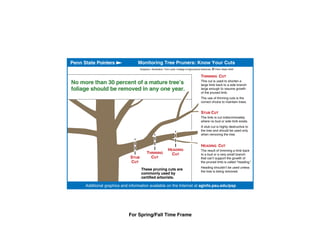trimmingtree04352_c
- 1. No more than 30 percent of a mature treeâs foliage should be removed in any one year. STUB CUT THINNING CUT HEADING CUT Graphics / Illustration: Tom Laird, College of Agricultural Sciences. ÂĐ Penn State 2000 Monitoring Tree Pruners: Know Your Cuts Additional graphics and information available on the Internet at aginfo.psu.edu/psp Penn State Pointers For Spring/Fall Time Frame THINNING CUT This cut is used to shorten a large limb back to a side branch large enough to resume growth of the pruned limb. The use of thinning cuts is the correct choice to maintain trees. STUB CUT The limb is cut indiscriminately where no bud or side limb exists. A stub cut is highly destructive to the tree and should be used only when removing the tree. HEADING CUT The result of trimming a limb back to a bud or a very small branch that canât support the growth of the pruned limb is called âheading.â Heading shouldnât be used unless the tree is being removed. These pruning cuts are commonly used by certified arborists.

